
Is Anxiety Ruining Your Sleep? 5 Tips to Relieve Anxiety Before Bed
We've all been there -- staring at the ceiling, reliving every misstep and embarrassing moment of our entire lives. Having trouble sleeping is particularly common among those who have anxiety disorders. Our autonomic nervous system releases the primary stress hormone cortisol to mediate our response when we're anxious. Research suggests that cortisol may be keeping us up at night.
Anxiety and insomnia can form a vicious cycle of sleepless nights. Anxiety can keep you up, and insufficient sleep can amplify anxiety symptoms. Some days it's a catch-22 that you can't seem to shake. Use these five tips to manage your anxiety and get some sleep.
1. Ritualize your nighttime routine
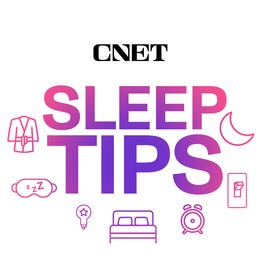
Not only does a routine help you relax enough to fall asleep, but it also helps combat stress and reduces symptoms of anxiety. Your nighttime routine will help keep you focused on relaxation and sleep. Everyone's routine is going to look different. Maybe yours includes light yoga or an hour of journaling to reflect on your day. Whatever it is, it's important to stick to your nightly routine when you find it -- do it at the same time and in the same order each night. Completing tasks in your nightly routine will signal to your brain that it's time to start winding down for sleep.
Another mini tip within this tip: Don't lay in bed awake. If you climb into bed and find that you're not falling asleep, don't stay in bed. Instead, get up and do something relaxing, like read a book or take a bubble bath. The last thing you want to do is associate your bed with scrolling through social media or watching TV.
2. Limit alcohol and caffeine intake before bed
I know this one can be a bit of a bummer, but what you eat and drink can affect your anxiety and how you sleep. Caffeine relates to anxiety and sleep in two ways. First, too much caffeine can exacerbate feelings of anxiety. The second is the obvious one; caffeine keeps you awake. As a rule, you should avoid drinking caffeine for six hours before you go to bed.
Alcohol can also affect your anxiety symptoms and sleep by throwing off your circadian rhythm. Even if you find it easier to fall asleep after a few cocktails, many people wake up a few hours later when their body metabolizes the alcohol. Avoid drinking alcohol at least four hours before you go to sleep.
3. Try a meditation app
Meditation apps are a quick and easy way to help yourself relax and fall asleep. Research shows that meditation can reduce stress and anxiety levels. It also reduces your blood pressure and heart rate. With the best meditation apps, you choose from guided meditations, deep breathing exercises or calming stories. There are a ton of options out there. Top meditation apps even have guided segments from celebrities like Harry Styles or Idris Elba.

4. Sleep with a weighted blanket
Weighted blankets have been found to be an effective way to help calm anxiety and help you fall asleep, thanks to what's called deep-pressure stimulation. A 2020 study found that people who use a weighted blanket have lower rates of insomnia and anxiety. Using a weighted blanket isn't the only thing you should do, but it is an easy way to integrate comfort into your nightly routine. You can choose from the hundreds of options on the market or even make your own weighted blanket.
5. Don't ignore your anxiety
All the tips in the world won't help you sleep easier with anxiety if you don't acknowledge you're feeling anxious. Whatever you're feeling -- stressed, scared or worried -- accept it so you can address it.
It's a good idea to try to incorporate stress-relieving activities into your daily routine to help keep things from building up at night. Try a daily walk or other exercises to reduce anxiety. There's no set time frame for when you'll start falling asleep faster -- it likely won't be instantaneous. However, if you find that your anxiety is continually getting the best of your sleep, it may be time to talk to someone.
The information contained in this article is for educational and informational purposes only and is not intended as health or medical advice. Always consult a physician or other qualified health provider regarding any questions you may have about a medical condition or health objectives.
Source
Tags:
- Anxiety About Going To Sleep
- How Anxiety Ruins Your Life
- Driving Anxiety Is Ruining My Life
- Anxiety Ruining Relationship
- Is Anxiety Genetic
- Is Anxiety A Mood Disorder
- Is Anxiety Curable

HBO Max's Raised by Wolves combines Ridley Scott style with creepy robots
Parenting is tough. You've got to keep your kids safe and warm and clean, teach them useful stuff, and make sure they don't get killed in an apocalyptic war between atheist technocrats and religious zealots. Oh, and you're an android.
That's the premise of Raised by Wolves, a slightly bonkers and luridly pulpy new sci-fi series given a sheen of prestige TV by the involvement of legendary Alien and Blade Runner director Ridley Scott. Raised by Wolves premieres on streaming service HBO Max Thursday, Sept. 3.
The show revolves around a group of human youngsters stuck on a distant planet where they're nurtured by a pair of sinister androids called Mother and Father. The parental units wear sleek rubber outfits and cock their heads while talking. Father does the heavy work and tells dad jokes. Mother spits out catty remarks and murders people by screaming at them. Parents, eh? So embarrassing.
These robots are more than unfeeling automatons, mainly thanks to enormously watchable performances from Amanda Collin and Abubakar Salim. They invest the oddball androids with strange but genuinely relatable emotions and personalities, making them vulnerable and volatile. Collin in particular seethes with terrifying unpredictability.
The first episode feels like a pulp sci-fi short story, but things expand slightly with the arrival of an ark full of surviving humans from the wrong side of the conflict that wiped out Earth. There's probably enough planet for everyone to share... but this isn't that type of show, and jaw-droppingly gory violence perpetuates itself on this new world. The mechanical mom on one side is mirrored by human parents on the other who have their own emotional issues and deadly secrets. Which is surely relatable to anybody with kids.

Travis Fimmel is a soulful human with a terrible haircut and an emotional connection.
HBOIt's deliciously violent, weird and streaked with symbolism. But having seen the first few episodes, it's hard to know if Raised by Wolves has enough going on to sustain itself. The hostile alien planet is a pretty tired formula, and the premier episode teases a larger story only to boil things back down to a much more basic setup. The androids are watchably weird, but it's the actual humans who have to make a real emotional connection, and a lot of the weight rests on the burly shoulders of Warcraft and Vikings veteran Travis Fimmel. He brings a smoldering depth to his character, but he's only one man amid a number of less developed characters.
The main point of familiarity comes from Ridley Scott, the director behind films like Alien, Blade Runner and The Martian. He's had an outsize impact on science fiction over the past few decades, to the point that his visual and thematic preoccupations have become instantly recognizable. Although the show is created by Aaron Guzikowski, Scott directs the premiere episodes and packs them with assorted signature Scottisms: socially awkward robots, machines called "mother," milky nosebleeds, eye motifs, the monstrous feminine, hostile planets that look like Iceland. And gray. Metaphorical shades of gray, sure, but also literally everything is literally gray.
Scott also combines the look and feel of his sci-fi work with that of his muddy, bloody historical epics. The world of Raised by Wolves has been torn apart by a religious war between angry atheists and sun-worshipping zealots, and amid the gray landscapes the show is filled with old-school fire and brimstone religiosity. It's a postapocalyptic future, but the medieval tunics and pious haircuts make it feel like a new Dark Ages. As in many of his previous films, Scott claims not to believe in God while his creations exhibit godlike powers. And of course they're cruel gods, like all parents.
With Ridley Scott channeling himself so obviously, Raised by Wolves feels pretty familiar. An alien -- as in, the alien, from the Alien movies -- could jump out at any moment and it wouldn't be that much of a shock. That's not necessarily a bad thing, however. The gritty world-building means that if an alien -- the alien -- did pop up, it would automatically catapult Raised by Wolves into the upper (or at least mid) table of most interesting Alien stories. It'd certainly leapfrog Scott's dismally derivative Alien: Covenant, not to mention ponderous prequel Prometheus.
The pseudo-medieval aesthetic and angry androids also make it feel a bit like Game of Thrones and Westworld, HBO's previous sci-fi/fantasy smash hits. Every streaming service has been trying to make the new Game of Thrones for years, which is fine, but instead of something as startlingly fresh and groundbreaking as GoT was when it began, we get a generation of shows that just really look like Game of Thrones. See Netflix's The Witcher, Amazon's Carnival Row or Apple TV'sSee. Westworld also spawned a range of admirers, like Peacock's Brave New World, and that DNA is in Raised by Wolves too. Still, if you can ignore the shadow of Thrones and Westworld, these shows all have their lurid charms -- it's actually a pretty good time for mad, nasty, adult sci-fi.
Raised by Wolves is certainly all those things, and if it's not game-changing, it's at least entertaining. Put the kids to bed and enjoy.
Source
Tags:
- Hbo Max S Raised By Wolves Combines Ridley Scott Style With Sanaz
- Hbo Max S Raised By Wolves Combines Ridley Scott Style With Vans
- Hbo Max S Raised By Wolves Combines Ridley Scott Style Beats
- Hbo Max S Raised By Wolves Combinesell
- Hbo Max S Raised By Wolves Trailer
- Hbo Max S Raised By Wolves Clothing
- Hbo Max S Raised By The Wolves
- Hbo Max S Raised Vegetable Gardens
- Hbo Max S Raised Bed
- Hbo Max Shows
- Hbo Max Student Discount
- Hbo Max Movies
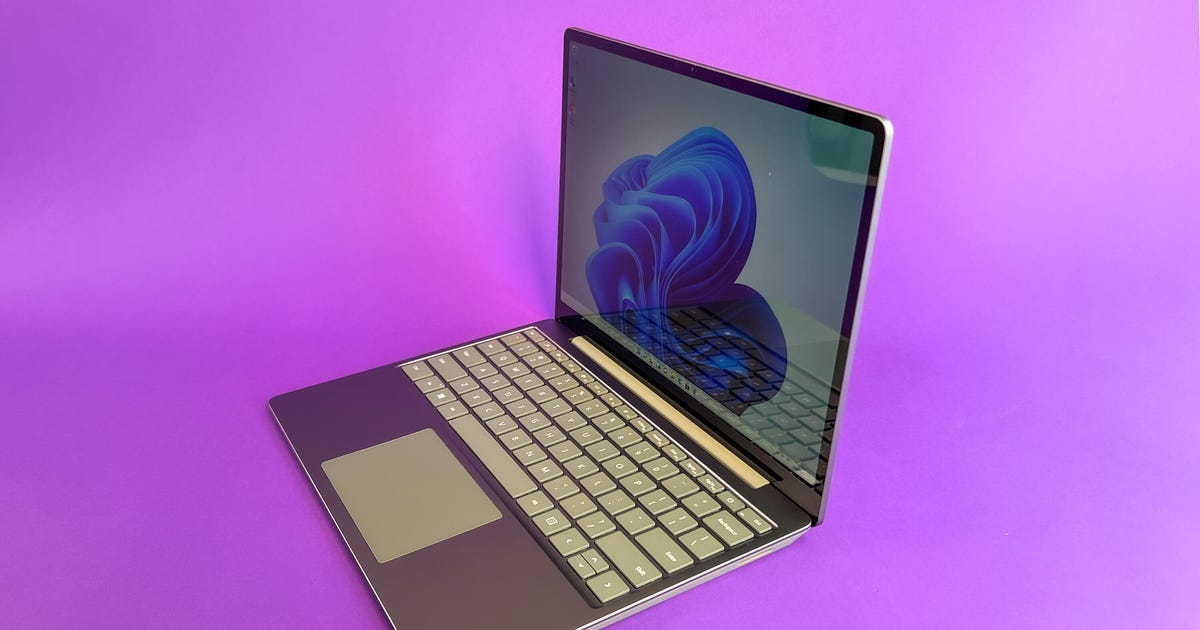
Microsoft Surface Laptop Go 2 Review: The Tricky Math of Budget Laptop Buying
Now that I've had some more time to spend with Microsoft's latest PC, the Surface Laptop Go 2, it's become one of my go-to travel laptops for quick trips to the coffee shop. It also acquitted itself well on a cross-country flight, even when the person in front of me insisted on leaning their seat all the way back.
But it's also a laptop that exposes the nearly impossible juggling of price and feature concessions required to make a budget (or budget-adjacent) laptop in 2022. That alone makes this a different experience than the original Surface Laptop Go from 2020.
Compared to that first model, this one is a little more expensive, but it's also a little better. Maybe more than a little, depending on the configuration. The second version of Microsoft's Surface Laptop Go is a take on the budget laptop genre that also has to skirt current economic issues which have pushed our definition of a budget laptop higher. The base model Surface Laptop Go 2 starts at $600 (£529, AU$1,199).
The original Surface Laptop Go tried to take the all-over excellent design of the Surface Laptop, one of my mainstream favorites, and strip it down for budget buyers. It ended up as a $550 laptop with a 12.4-inch screen and a 10th-gen Intel Core i5. The big issue it had was that the base model, despite an appealing price, was stuck with an unappealing combination of 4GB of RAM and a scant 64GB of solid state drive storage. At the time, I suggested that the middle-ground $700 version, with 8GB RAM and 128GB SSD, was the only configuration that made sense as a budget laptop.
Read more: How to Buy a Budget Laptop
The more things change…
The new 2.0 version makes a few changes, but maybe not enough. The first is that we're now starting at a little more, at $600. At least you get 128GB of storage now, but still the same 4GB of RAM. Windows 11 is the OS, replacing Windows 10 S (remember that?), and the CPU goes from a 10th-gen Intel Core i5 to an 11th-gen Intel Core i5. Especially for a budget laptop, that's fine, but keep in mind, most new laptops have more recent 12th-gen Intel chips, so this is a full generation behind.
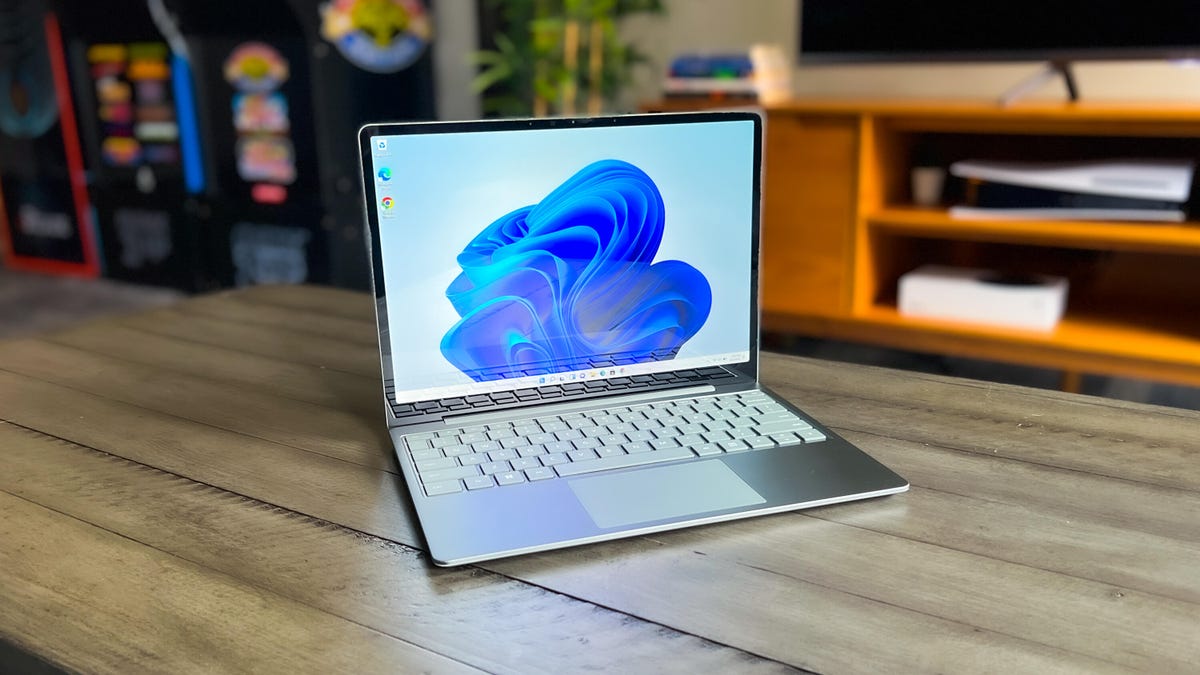
The screen size and resolution, weight, port selection and the overall design on the new Surface Laptop Go 2 are the same as the original version. That includes the meh resolution of 1,536x1,024, but it's also a touch screen, and pretty bright and clear for a budget laptop.
The webcam is still a lower-res 720 model, but Microsoft says software tweaks give it better color accuracy and noise reduction. During the COVID-19 pandemic, many laptops have finally moved to full HD webcams, with 1,920x1,080 resolution, so I don't think this will become my main Zoom (or Microsoft Teams!) meeting device.
Microsoft says the new version is greener, which works in its favor, with 30% post-consumer recycled plastic. It also has a decent level of repairability, with the ability to change the SSD and battery, among other parts. You can't change the RAM or CPU, however, as far as I can tell.
Microsoft Surface Laptop Go 2 (2022)
| Price as reviewed | $799 |
|---|---|
| Display size/resolution | 12.4-inch 1,536 x 1,024 touch diplay |
| CPU | 2.4GHz Intel Core i5-113G7 |
| Memory | 8GB DDR4 RAM 3.1GHz |
| Graphics | 128MB Intel Iris Xe graphics |
| Storage | 256GB SSD |
| Networking | Wi-Fi 6: 802.11ax Bluetooth Wireless 5.1 |
| Operating system | Microsoft Windows 11 Home 21H2 |
Budget laptop math
My thinking on budget laptops has changed, pushed by inflation, supply shortages and the increase in work-from-home and remote school scenarios. As outlined in my recent guide to buying a budget laptop, the old $500 limit to what we'd consider "budget," has been pushed up closer to $700. That's because, even for a low-cost laptop, you should be looking for an Intel Core i5 or equivalent processor, 8GB or 16GB or RAM and 128GB or 256GB of storage.
You can probably see where this is headed. The lowest-end Surface Laptop Go 2 (like the original) has 4GB of RAM, which I'd consider a red flag. For both generations of this product, Microsoft sent me an upgraded model with 8GB of RAM to test. Yes, Microsoft says 4GB is officially supported for Windows 11, but I think the RAM upgrade is going to give you a much more satisfying experience. For $700, you can get the same Core i5, but with 8GB RAM and 128GB storage. For $800, it's 8GB RAM and 256GB storage. There's a separate "business" version that has a 16GB RAM option, but you'll have to find that from a specialty business computer reseller.
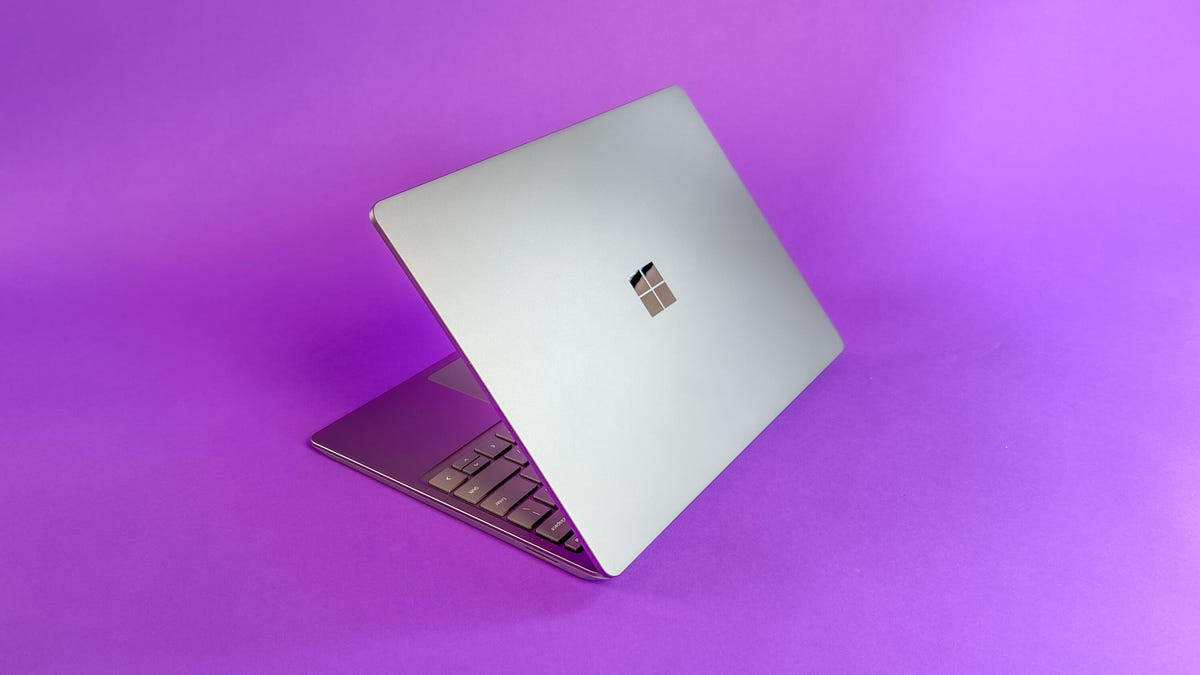
My next mental hurdle is that once I'm at $800, I'm out of the budget laptop zone. I'd be tempted to spend a little more and look for a deal on an HP Envy or Dell XPS 13. Or, Microsoft's own premium Surface Laptop 4 (the latest version), which starts at... $800. But note that the $800 Surface Laptop 4 has an AMD Ryzen 5 central processing unit and 8GB RAM and 128GB SSD. You'll get a more premium design with a bigger, better display, but there's less storage and an arguably less powerful processor. So while that's tempting, I'd skip it.
That's a lot of comparison shopping just to come to the conclusion that, as with the original, I'd consider the $700 model the sweet spot, even if it skimps on the storage. Shopping for a budget laptop is frankly harder than a more expensive one, because you're always calculating the trade-offs between different features for the price.
Read more: Best Budget Laptop of 2022
Coach travel companion
So when I got the Surface Laptop Go 2 in my hands, the timing was perfect for actually going somewhere with it. I took it on a cross-country plane trip, which is about as serious a burn-in process for a new laptop as you can find.
It looked, felt and performed much like the original model, which I liked a lot, even if it didn't become an everyday laptop for me. It still looks and feels like a much more expensive machine, thanks to the aluminum body, excellent keyboard and spacious-feeling 3:2 aspect ratio display. It feels almost as rugged as a MacBook Air, and the hinge -- often a weak spot on cheaper laptops -- is stiff and runs almost the entire length of the screen.
The smaller size, close enough to a 13-inch laptop to be useful, but smaller than even a MacBook Air, fit well on my airplane tray table. The fingerprint reader built into the power button is fast and responsive, but it's not included in the least-expensive configuration.
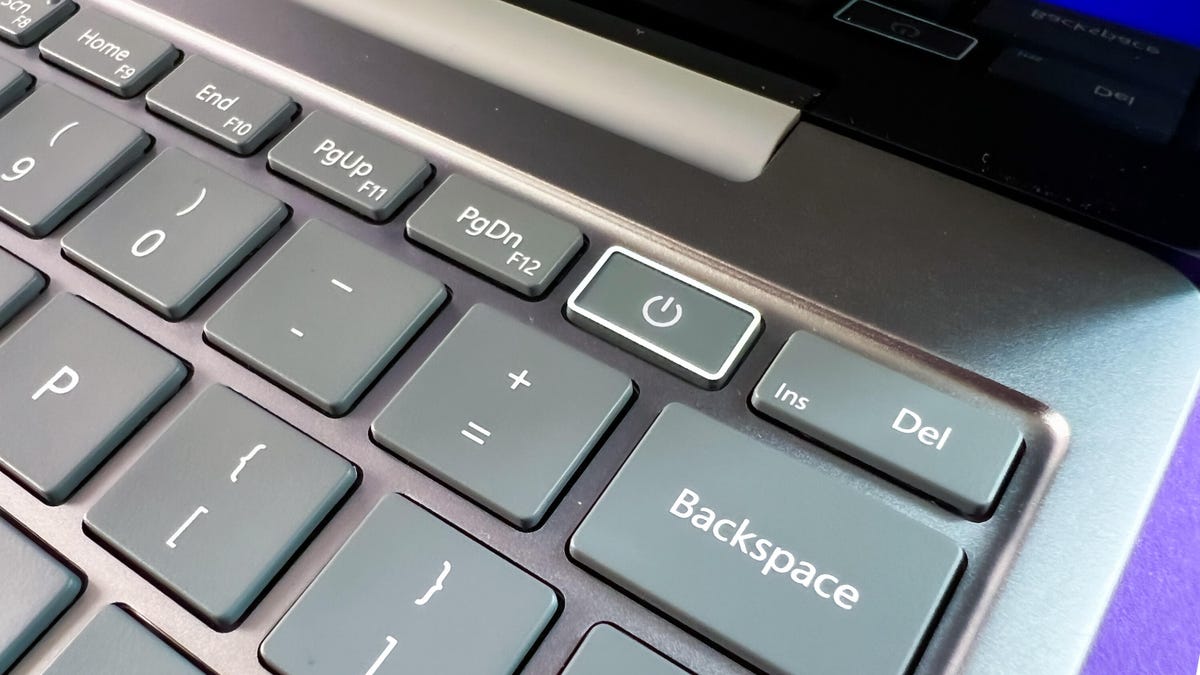
Running basic applications and web browsers were fine for everyday use, but I found myself defaulting to Microsoft's own Edge browser over Chrome, because it's better optimized for less powerful Windows 11 systems.
In our performance tests, the 2022 version, with its 11th-gen Core i5 was indeed faster than the 2020 version's 10th-gen Core i5. But other budget laptops, like the Gateway 14 or a couple of options with AMD Ryzen 7 processors, beat it out in benchmark tests. That Gateway, one of our current budget favorites, has the same processor, but includes 16GB of RAM and a big 512GB SSD, currently for $499. It is, however, not nearly as nice looking or well made as the Surface.
Despite other laptops offering better specs for the same or less money, the overall look and feel of the Surface Laptop Go 2 counts for a lot. A budget laptop isn't as useful if you don't enjoy actually using it. I'd call this a good laptop if you're interested in portability, looks and a great typing experience. But I'd only recommend it if you're also looking at the higher end of the budget scale, which I admit may be a thin slice of the laptop-shopping audience.
Originally published as an initial hands-on June 7, 2022.
Geekbench 5 (multicore)
Dell Inspiron 7415 2-in-1
Microsoft Surface Laptop Go 2 (2022)
Microsoft Surface Laptop Go (2021)
Note:
Longer bars indicate better performanceCinebench R23 (multicore)
Dell Inspiron 7415 2-in-1
Microsoft Surface Laptop Go 2 (2022)
Microsoft Surface Laptop Go (2021)
Note:
Longer bars indicate better performancePCMark 10 Pro
Dell Inspiron 7415 2-in-1
Microsoft Surface Laptop Go 2 (2022)
Microsoft Surface Laptop Go (2021)
Note:
Longer bars indicate better performanceSource
Tags:
- Microsoft Surface Laptop Go 2 Review The Tricky Part
- Microsoft Surface Laptop Go 2 Review The Watcher
- Microsoft Surface Laptop Go 2 Review The Ordinary
- Microsoft Surface Laptop Go 2 Best Buy
- Microsoft Surface Laptop Go
- Microsoft Surface Laptop 3
- Microsoft Surface Laptop Charger
- Microsoft Surface Pen
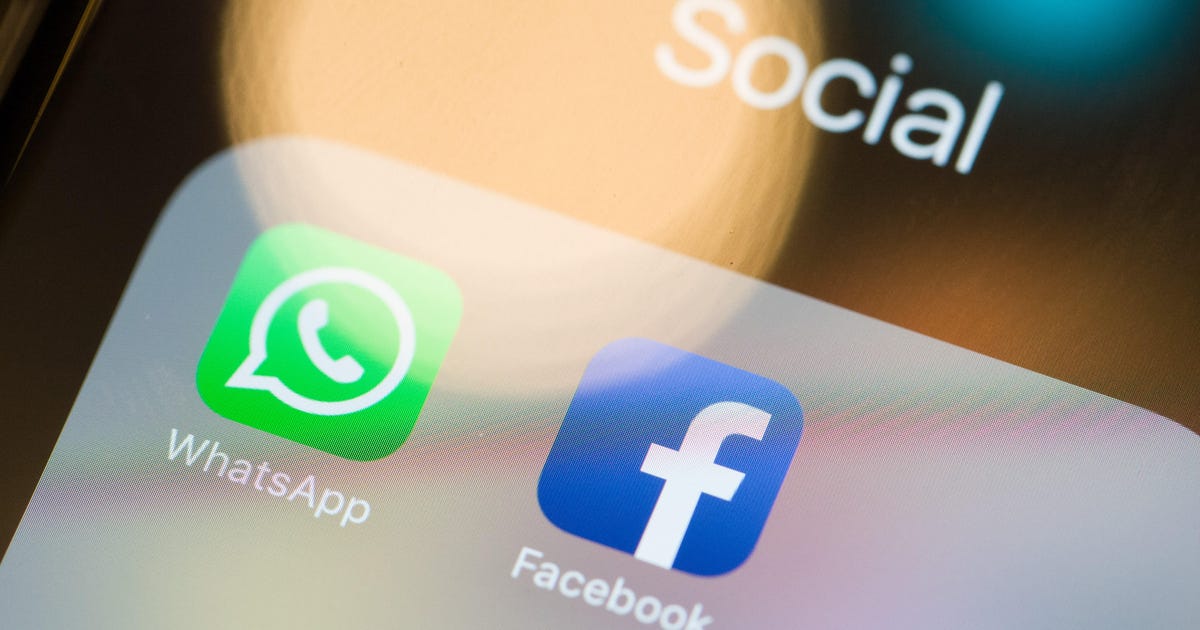
WhatsApp goes down for many across globe
WhatsApp wasn't working for many user across the world this morning.
Outages have been reported in the UK, Myanmar, Russia, Vietnam and Brazil.
The service began to function again about 30 minutes after the initial complaints, according to Reuters, although there are still some reports of issues on social media. It is not known why the outage occurred.
WhatsApp, owned by Facebook, is one of the world's most popular messaging apps with one billion daily active users.
Facebook bought WhatsApp in 2014 for a staggering $19 billion.
The company did not immediately respond to a request for comment.
Source
Tags:
- Why Is Whatsapp Down Today
- Has Whatsapp Gone Down
- Is Whatsapp Down Right Now
- Is Whatsapp Still Down
- Whatsapp Is It Down
- Why Is Whatsapp Down Today
- Is Whatsapp Still Down
- Whatsapp Goes Down
- Is Whatsapp Down Right Now
- How To Go Down A Line In Whatsapp Web
- Whatsapp Geschiedenis
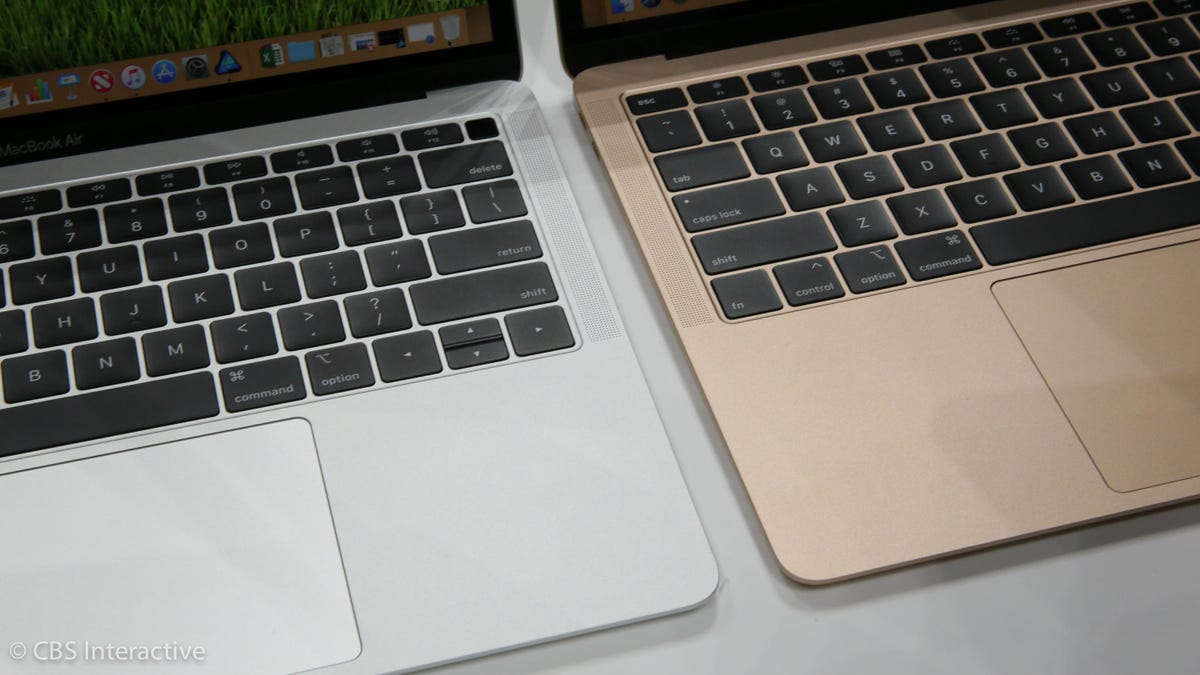
Apple MacBook Air (2018) review: The new MacBook Air hands-on: More pixels, fewer ports
It's called the MacBook Air, but it's an Air in name only. This new version of the popular laptop might as well be called the MacBook Pro Lite, because that's essentially what it is.
The long-standing tapered Air design, with its thick screen bezels, smallish touchpad, deep keys and multiple types of ports is gone, replaced by the familiar design cues of the post-2016 MacBook and MacBook Pro. If anything, the new Air looks and feels like a half-step between the 12-inch MacBook and the 13-inch MacBook Pro, rather than an evolution of the classic Air.
The new MacBook Air comes in space gray, silver and gold.
Sarah Tew/CNETIn person, as seen during a hands-on demo session following Apple's Oct. 30 event, it was hard to distinguish this new Air from Apple's other laptops at first glance. (One Apple rep misidentified a nearby new Air as a Pro to us.) Picking up the new Air, it immediately felt lighter and smaller than the current Air, which -- having had the same basic design since 2010 -- many of us are intimately familiar with.
You get more screen and less body, thanks to a display that cuts the thick bezel border by half and adds edge-to-edge glass over it. Now the Air display looks much like the one on the MacBook Pro, with a wider color range, although the Pro still has a lock on Apple's color-shifting True Tone display and support for the P3 color gamut.
At 2.7 pounds (1.25 kg) and about 15mm thick, its size and weight is actually very middle-of-the-road when it comes to 13-inch laptops. The slimmest systems get down under 10mm, but at the expense of battery, features and processing power. If you want super thin and light, step up to that aforementioned 12-inch MacBook for just $100 more -- but know you'll be losing considerable features and power.
While size and weight aren't particularly unusual versus other laptops in this price class, the new MacBook Air does feel substantially more solidly constructed than most of the competition. Like the current Pro and 12-inch MacBook, the new Air still feels as tough as a tank, with its one-piece aluminum construction (now 100-percent recycled aluminum, according to Apple). That's one of the reasons MacBooks, both Air and Pro, have been able to command premium prices for so long -- because you're making an investment in a product that will hopefully last for several years, which has often been the case for the traditional MacBook Air.
It's all about the keyboard
As the only MacBook with a traditional island-style keyboard, the MacBook Air was the one refuge for those who disliked the super-flat butterfly mechanism keyboards in newer MacBooks. Now the new Air is firmly in the same camp as the other models.
Some may lament the loss of the older style of keyboard. Personally, I've never found the butterfly keyboard as troublesome as others, and I've certainly dealt with more difficult keyboards in more expensive products. (I admit this may be a minority opinion.)
It takes a period of adjustment to get used to the subtle tactile feedback, but once you get used to it, it's fine for even long-form typing. But yes, you may never grow to love it.
But the positive tradeoff is that the new Air also includes a much bigger touchpad. It's the same Force Touch style as on all the other MacBooks, which means it doesn't have a diving-board hinge on the back, and instead uses four corner sensors to register clicks. The larger surface area is frankly more important than the mechanics behind it.
Will diehards take this change hard? They might, but that old keyboard was never as great as you remember, and the bigger touchpad is a great addition.
Apple October event: Complete coverage
Ports of call
If the keyboard change bothers you, the port situation isn't going to be much better. Following not only other Apple laptops but also many of the premium Windows laptops from the past two years, the MacBook Air is now USB-C only. That means any of your USB-A peripherals are going to need a dreaded dongle.
That said, it's got two USB-C ports, instead of the single one on the 12-inch MacBook, so you can do more than one thing at a time, like connect a peripheral and the power cable. And these are Thunderbolt 3-enabled USB-C ports, so they cover the full range of high-end duties: high-speed data transfer, for example, or output to 4K and 5K displays. External GPU boxes (eGPUs) are also supported, but I have yet to try one with the new Air. (Those tests will follow soon.)
But back to that power cable issue: The late, great MagSafe connector is gone, so one of those two USB-C ports will often be used for power. While it's great to see Apple using industry-standard USB-C ports for that -- you can invest in third-party USB-C power delivery (PD) battery packs, for instance -- it still means that you may be back down to a single open port.
The entry-level 13-inch MacBook Pro has a similar pair of Thunderbolt 3 USB-C ports, but lacks the Touch ID fingerprint reader found here. The fingerprint reader is really the best part of the Touch Bar experience, and it's a great addition to the MacBook Air. I didn't have a chance to register my own fingerprint and try it in action, but based on my use of the fingerprint reader in MacBook Pro systems (powered by the same T2 security chip), it's a system that works quickly and reliably.
Still the ultimate student laptop?
One area where the new MacBook Air may lose some ground is as the default student laptop on many college campuses (and the default work laptop at many companies). Even though this is a much better laptop in nearly every regard, it loses one big advantage the previous MacBook Air had -- its price.
At $999 in the US, the MacBook Air was an affordable luxury for many students, artists, writers and anyone who wanted a premium experience at a less-than-premium price. The new Air starts at $1,199 (£1,199, AU$1,849), which is a 20 percent jump, even though both the old and new entry-level models have 8GB of RAM and 128GB of solid state storage. That puts it just below premium laptops such as the $1,299 MacBook, which lacks a second USB-C port and fingerprint reader, and the $1,299 13-inch MacBook Pro, which lacks the fingerprint reader.
Keep in mind the Pro still has a few extra advantages. Its eighth-gen processors come from a faster family than the low-power ones in the new Air, and the Pro has faster eDRAM.
The overall design and usability, and the jump from fifth-gen Intel processors to eighth-gen ones, certainly makes this well more than $200 better than the old MacBook Air. But it also moves to being that much more of a stretch for many would-be owners.
Fortunately, that old-school Air is still available, at least for now, just as the old 13-inch MacBook Pro was for more than a year after the newest design debuted in 2016. If you're firm in your need for USB-A or HDMI ports, or an island-style keyboard, pick one up now, because no one knows how long it's going to last. But note that based on the past several years of concerns we've had about the low-res screen, thick bezel and outdated CPU, it's hard to recommend that classic model right now.
We hope to test and fully review the new MacBook Air soon, so stay tuned for our benchmark results and full review.
iPad Pro hands-on : Apple's other big reveal.
Everything Apple announced : Mac Mini, a new Pencil and more.
Source
Tags:
- Apple Macbook Air 2018 Review The New Macbook Air Handshake
- Apple Macbook Air 2018 Review The New Downton
- Apple Macbook Air 2018 Review The New Localism
- Apple Macbook Air 2018 Review The Lost
- Apple Macbook Air 13
- Apple Macbook Air A1466
- Apple Macbook Pro
- Apple Macbook Air
- Apple Macbook Pro 16
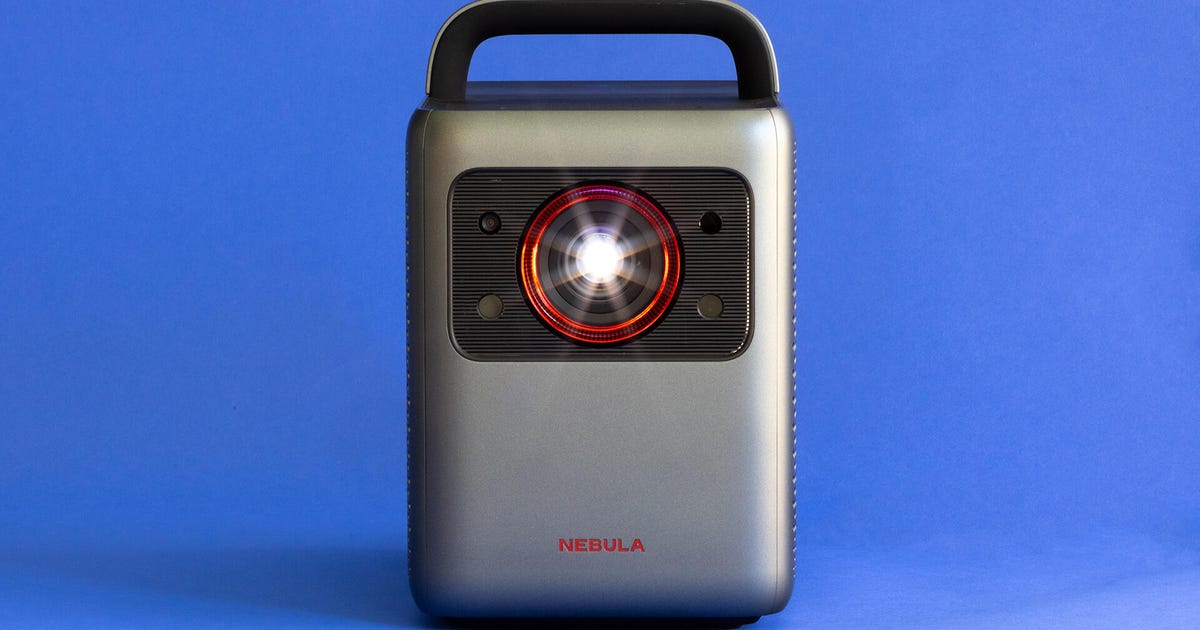
Anker Nebula Cosmos Laser 4K Projector Review: Get a Handle on 4K Lasers
Let me say this up front: the Anker Nebula Cosmos Laser 4K is a weird product. Not necessarily in a bad way, it's just… different. This projector is trying to find -- or perhaps forge -- a particular niche, and I'm not entirely sure it can pull it off. With its handle and compact size it's easily tote-able, like other portable projectors, but at its $2,200 list price, it's really expensive for something that you'll haul around like a cheap Bluetooth speaker.
Like
- Bright
- Compact
- Android TV built-in
Don't Like
- Expensive
- No zoom
- Few picture adjustments
The Anker Nebula Cosmos 4K Laser does a number of things well. It's exceptionally bright with decent image quality, it has streaming built-in, and its speakers play loud enough for their size.
But in the end, it simply costs too much for what you get. Numerous cheaper projectors, such as Anker's own Nebula Mars 2 Pro, are just as compact, if not as bright or high-resolution. In fact, since the Nebula 4K Laser lacks a battery and needs to be plugged in, it's less versatile than many other compact projectors. Meanwhile its lack of zoom, average overall performance and limited picture adjustments put it a step behind more traditionally configured 4K projectors. That's not the entire story, however.
Cosmos by the numbers
- Resolution: 3,840x2,160 pixels
- HDR-compatible: Yes
- 4K-compatible: Yes
- 3D-compatible: No
- Lumens spec: 2,400
- Zoom: No
- Lens shift: No
- Laser life: 25,000 hours
The Cosmos Laser 4K is, you'll be surprised to learn, a 4K laser projector. It's rated at 2,400 lumens. I measured it at 1,607, which is very good. In fact, the brightness and the effectively eternal laser light source means the Cosmos Laser 4K will be brighter for longer than lamp-based projectors, without having to pay for new lamps every few years.
However, there's no zoom or lens shift, so placing the Cosmos Laser 4K is more finicky than traditional 4K projectors. If you have a screen already, there's exactly one place you can put the projector. An inch closer, and you don't fill the screen. An inch too far, and the image overflows around the edges. The lack of lens shift isn't surprising; most projectors in this price range don't have it. However, there's only a modest upward throw, so if you're expecting to put it on a coffee table, I hope your screen is pretty low.
The autofocus works quickly, which is good. Like most portable projectors, there's also automatic keystone, which you should always turn off.
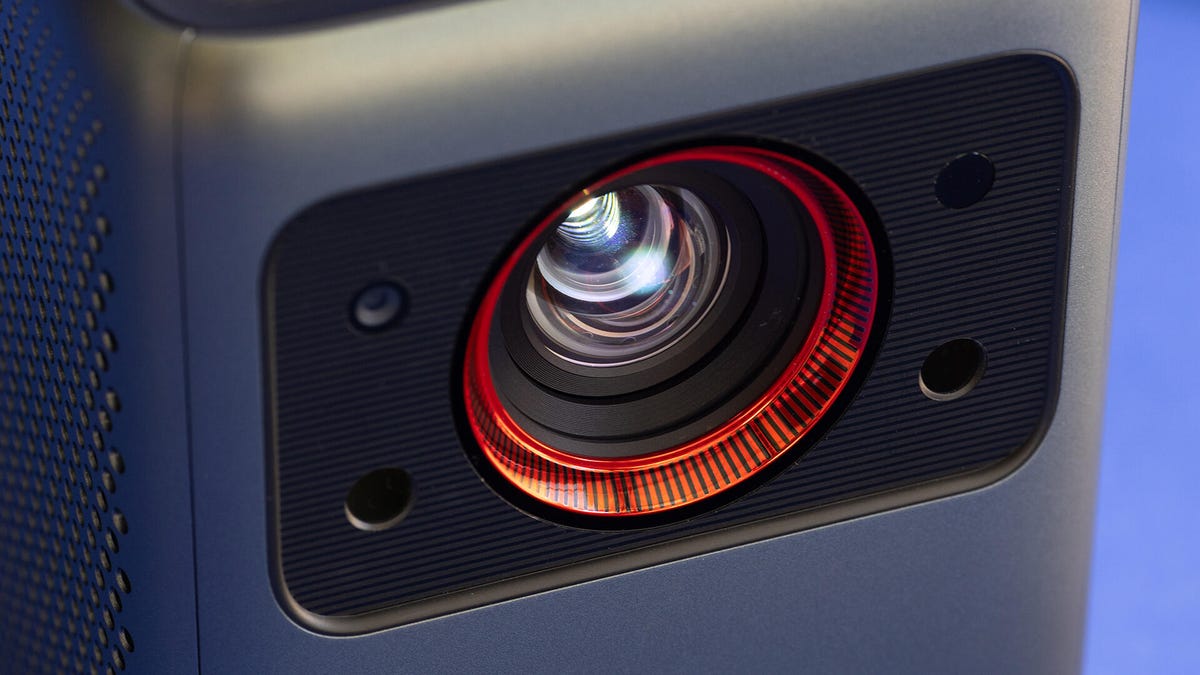
Then there's the massive handle, the Cosmos Laser 4K's most obvious design feature. I suppose it makes the projector more "portable." However, at the same weight as most other projectors in this price range (10.7 pounds), you'll need a really big backpack to lug it around.
As I mentioned, there's no battery. Wherever you end up using it, you'll need power, just like every other "traditional" projector.
At maximum volume the speakers play loud enough, but certainly not something that would fill a backyard. If you're ear-level and in line with the speakers it can be quite piercing. It has more bass than you'd expect, and given that no projector sounds "good," overall this isn't a big deal. (Editor's note: an earlier version of this review misattributed who designed the speakers. According to Geoff, this mistake was due to an excess of juice during the writing of the review, though not during testing).
A nice collection of connections
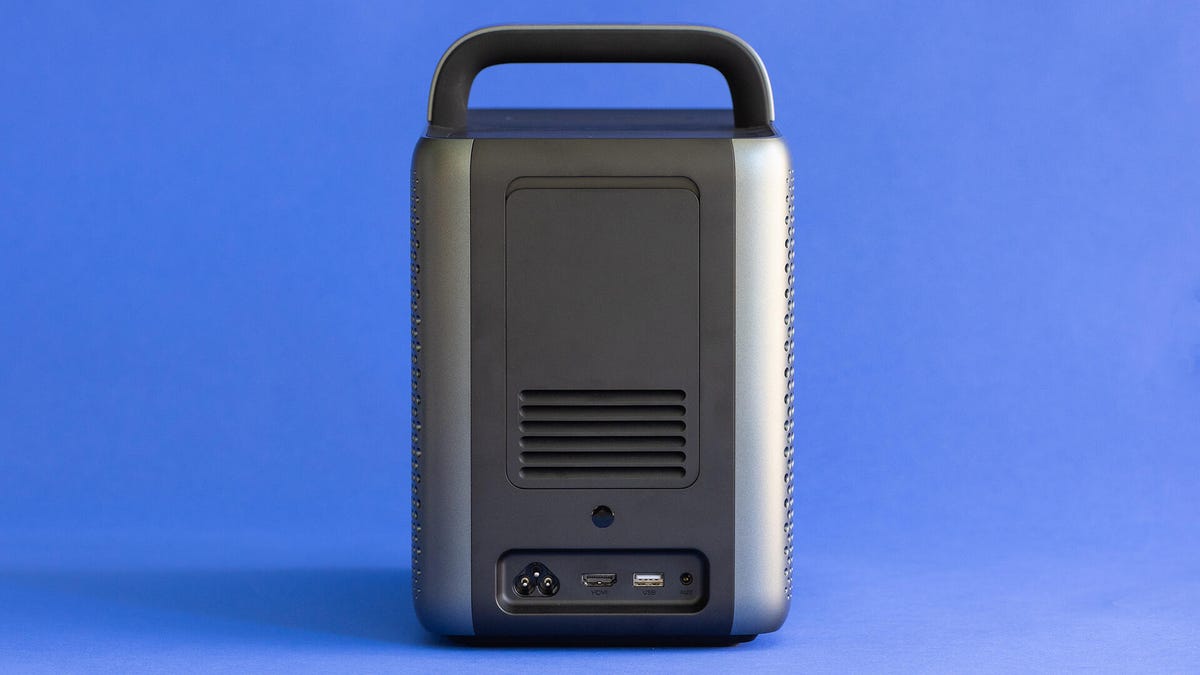
A rear view showing the HDMI and USB inputs. Note the big handle.
Geoffrey Morrison/CNET- HDMI inputs: 1
- USB port: 1
- Audio output: Bluetooth
- Internet: 2.4GHz/5GHz
- Remote: Not backlit, also an app (Android/iOS)
On one hand, there are very few physical connections: just one HDMI and one USB. Honestly, though, you don't need more than that with projectors. Even if you were to use the Cosmos Laser 4K in a traditional role in a home theater, you're only running one HDMI cable to the projector, ideally using a receiver or soundbar as the HDMI switcher.
I appreciate that actual Android TV is built in. While not as smooth an interface as, say, Roku, it works well enough. You do get all the major streaming services, like Disney Plus, HBO Max, and so on. There are a few quirks, like no 4K with Vudu, but that's a minor knock.
In everyday use, Android TV behaves like a layer placed on top of the projector's base user interface. Basically anything I needed to do to the projector required multiple, sometimes unintuitive, steps. Certain related settings are in entirely separate menus. If all you want to do is turn on and zone out to some Netflix, that's easy enough. If you want to change the brightness or adjust some picture settings so the image looks better, it all takes far more steps than the single-button access other projectors have.
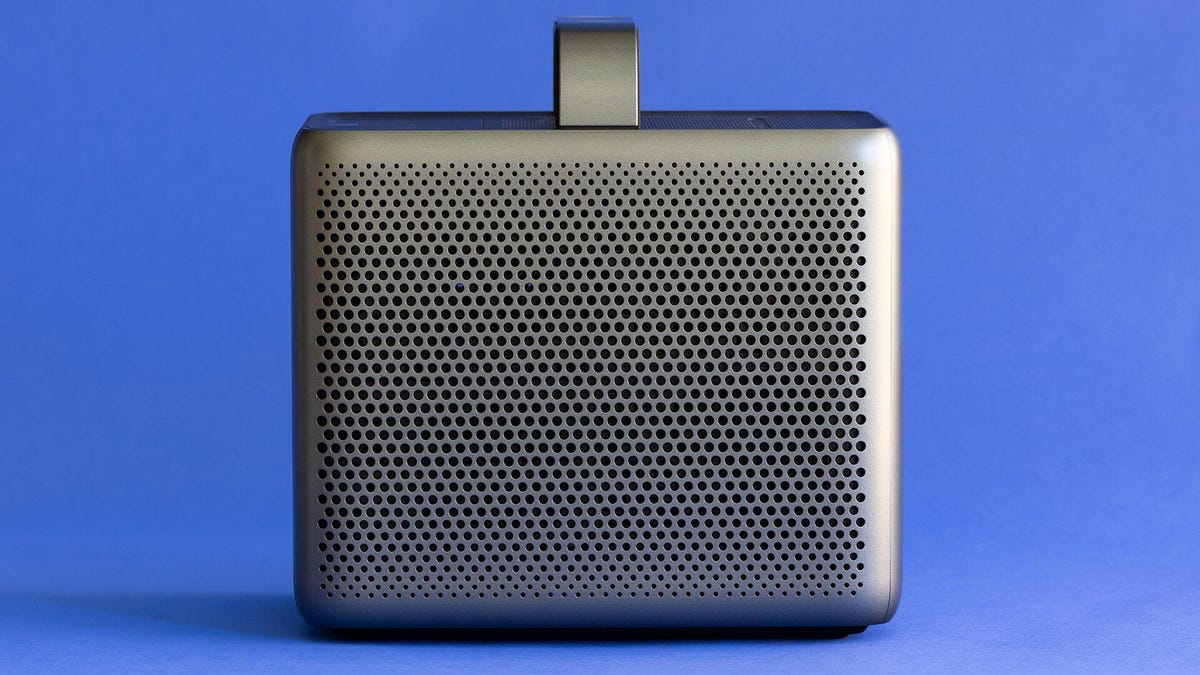
Not that there are a lot of picture settings. There are far fewer adjustments here than other projectors, an issue we've mentioned in other Anker projector reviews.
The remote is also a bit troublesome. During the initial setup you need to program which buttons control the volume, access the HDMI input and so on. Worse, if the projector decides to "forget" these selections, which it did mid-review for me, you're stuck with the volume set at whatever it was before the remote was forgotten. At the same time I tried to reconnect the app and that, too, wouldn't connect. I did eventually get it working again, and multiple firmware updates have been released to address this issue, so hopefully Anker will have it worked out by the time you read this.
Picture quality comparisons
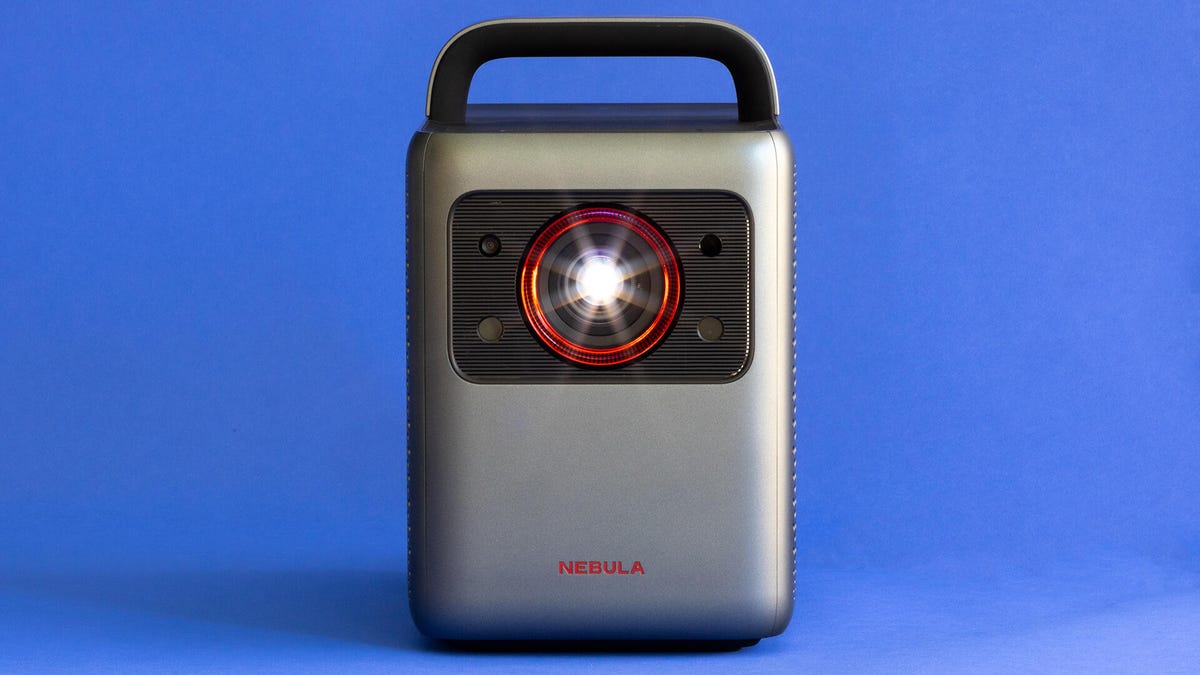
For my comparisons I chose the Optoma UHZ50 4K laser projector, as old-school a design as a 4K laser projector can be. It's $500 more expensive, so in roughly the same price ballpark, but has zoom, lens shift and far more picture adjustments than the Anker. I connected both projectors to a Monoprice 1x4 distribution amplifier and viewed them side-by-side on a 102-inch 1.0-gain screen.
Looking at the specs, these projectors should look extremely similar, and on my screen they did as well, at least at first glance. Light output is basically the same, with a slight nod to the Anker.
The Optoma had a clear advantage in contrast ratio however, so its image had more depth and looked less washed-out than the Anker's. I measured a contrast ratio of 652:1 on the Anker, which certainly isn't bad compared to this category of projectors, but the Optoma measured 1,007:1 and was visibly superior.
The most noticeable difference, however, is the color. First, the Anker has a slight greenish tint, which was noticeable side-by-side against the Optoma, but in isolation wouldn't be a big deal. Beyond that, however, the Optoma just looks far more natural. Greens look a bit too green on the Anker. Caucasian skin tones, for example, look a bit more artificial, with a slight pallor compared to the Optoma. In-between tones are a little off as well. A salmon-colored jacket on the Optoma looked beige via the Anker.
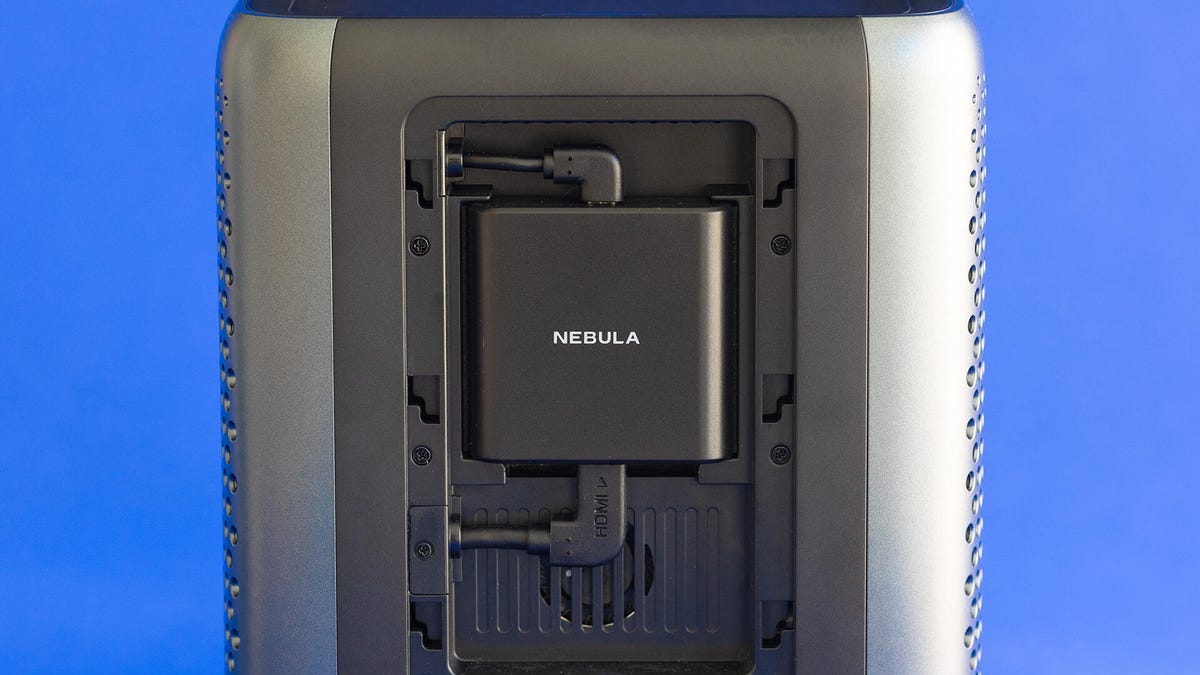
The small included streaming device is usually hidden behind a removable panel.
Geoffrey Morrison/CNETI didn't have the UHZ50's cheaper brother, the UHD35, on hand for comparison. That projector is basically the same size as the UHZ50, but costs $1,350. It's only slightly dimmer than the Cosmos Laser 4K (1,567 vs. 1,607 lumens), which won't be noticeable. The contrast ratio is effectively the same, 649 vs. 652:1. No streaming on the UHD35, but it does have a bit of zoom. You'll have to replace the lamp every few years, but said lamps are around $100. So even if you're watching for four hours a night, every night, on the highest lamp setting, that's over 22 years before you'd cover the price difference. Which is to say, for way less money you'll get a similar image, more flexible permanent placement, or roughly the same portability -- minus the big handle, of course.
Overall the Anker doesn't look bad by any stretch. But with a price this high, "not bad" is hardly a selling point.
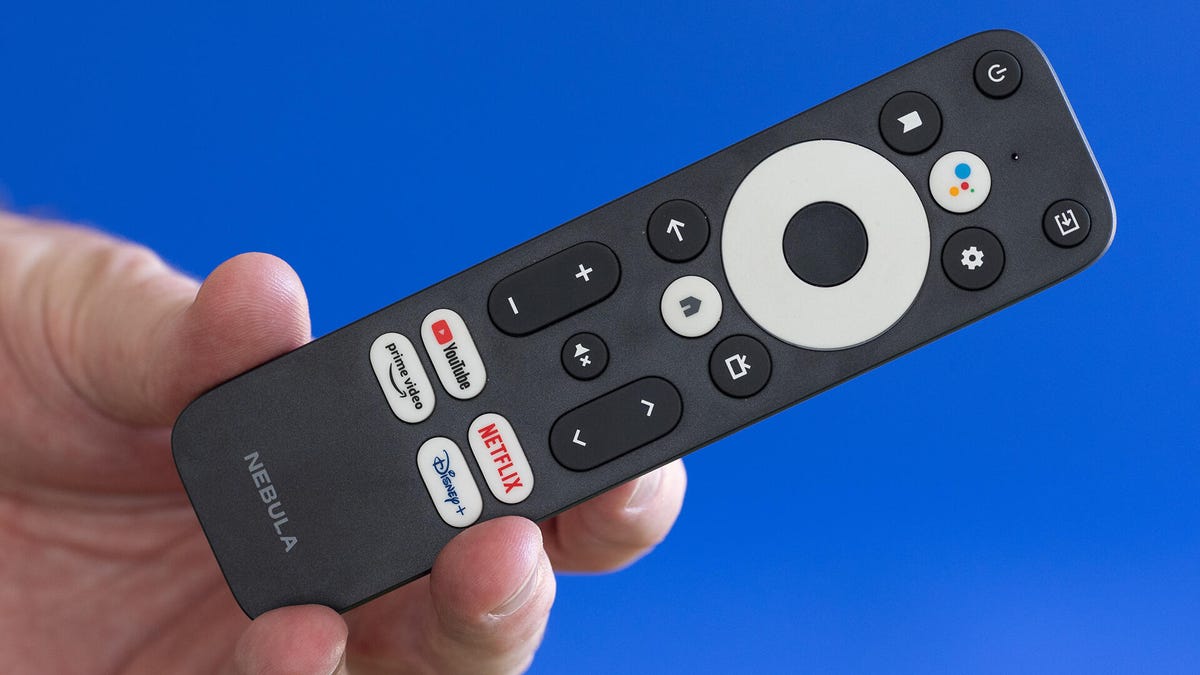
A Cosmos of possibilities
The best way to think about the Cosmos Laser 4K is that it's a portable projector on steroids more than a home projector with a big handle. That doesn't excuse its missing features and performance as much as it explains some of it. For $2,200, however, I don't think it's unreasonable to expect more of both.
In the end I don't quite get who this projector is for. To me, an expensive projector calls for a home theater environment, with speakers and a real screen. If you want something temporary and highly portable, two grand is a lot of money to be lugging around, big handle or not. Sure, the Cosmos Laser 4K is far brighter than your typical portable projector, but really, is the Optoma UHZ50, which you could carry with one hand in a pinch, that much less "portable"?
If portability is what you're looking for, I suggest going for something smaller, cheaper and battery-powered. If you drop it, or it gets knocked over by partying racoons, it's less of a loss. Anker's own Mars II Pro is far dimmer and has way less resolution, but it works great in that role. You just can't have as large of a screen for your outdoor movie nights, but you wouldn't need to run an extension cord.
If you're in the price range of the Cosmos Laser 4K, I think the greater adjustability, flexibility and image quality of the Optoma UHZ50 or UHZ35 is a better choice.
Source
Tags:
- Anker Nebula Cosmos Laser 4k Projector Review Get Flawless Brows
- Anker Nebula Cosmos Laser 4k Projector Review Get Paid
- Anker Nebula Cosmos Laser 4k Projector Review Get Vaccine
- Anker Nebula Cosmos Laser 4k Projector
- Anker Nebul a Cosmos Max 4k
- Anker Nebula Cosmos Laser 4k
- Anker Nebula Cosmos
- Anker Nebula Mars Ii Pro
- Anker Nebula Solar Portable
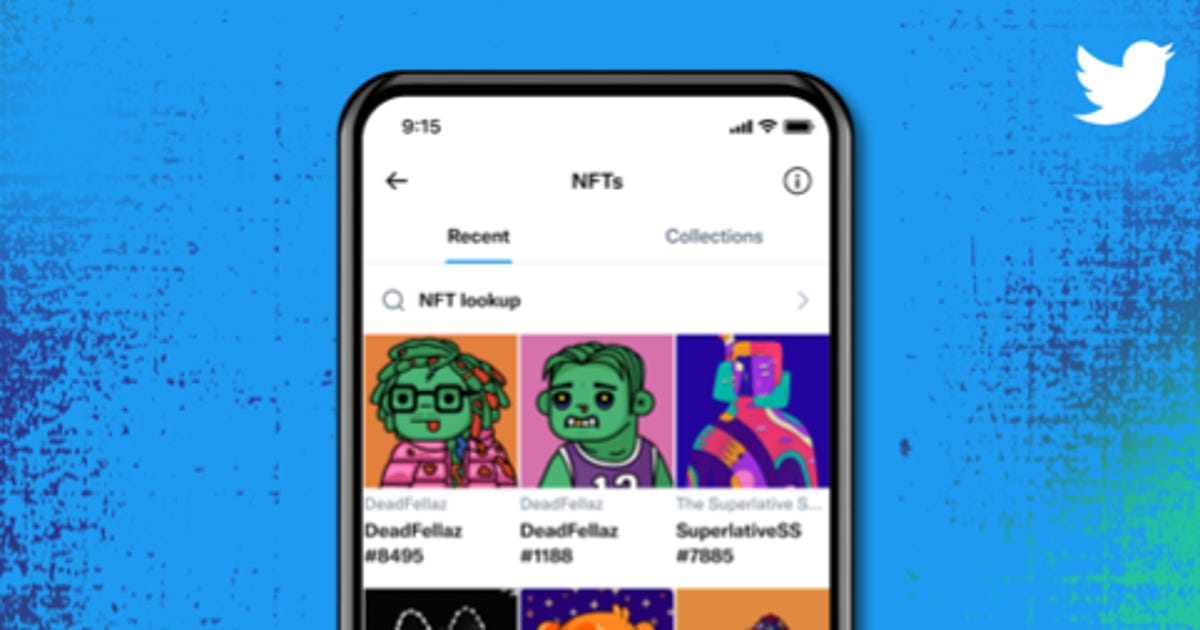
Twitter rolls out a way to showcase your NFTs
Twitter said Thursday that it's introducing a way for people to showcase their nonfungible tokens, or NFTs, which are assets verified using blockchain technology.
The company is offering users of Twitter Blue, a subscription service that costs $3 per month, the ability to create NFT profile pictures. Twitter Blue includes early access to new tools. The release of NFT profile pictures highlights Twitter's efforts to rope in new users and make money outside of ad sales.
"This new feature provides a seamless, user-friendly way for people on Twitter to verify their NFT ownership by allowing them to directly connect their crypto wallets to Twitter and select an NFT from their collection as their new profile picture," Twitter said in a statement.
The company said in September that it was looking into NFT authentication on its platform. An authenticated NFT on Twitter will appear as a hexagon-shaped profile picture. When users tap on the profile, they'll be able to learn more about the asset.
NFTs can be used to represent the ownership of unique digital or physical items such as art, music or even a tweet. Twitter co-founder and former CEO Jack Dorsey sold his first tweet as a NFT for $2.9 million. The company said NFT profile pictures will roll out first to iPhone users who subscribe to Twitter Blue and that Android and web access will come later.
Source
Tags:
- Twitter Rolls Out A Way To Showcase Your Nfts Explained
- Twitter Rolls Out A Way To Showcase Your Nftscoring
- Twitter Rolls Out A Way To Showcase Your Nfts Market
- Twitter Rolls Out A Way To Showcase Your Talent
- Twitter Rolls Out A Way To Showcase Your Skills
- Twitter Rolls Out A Way To Showcase Synonym
- Twitter Rolls Out A Way To Showcase In French
- Twitter Rolls Out A Way To Showcase In Spanish
- Twitter Outstanding Shares
- Twitter Outage

At CES 2022, AMD hit all the gaming targets
This story is part of CES, where CNET covers the latest news on the most incredible tech coming soon.
Based on its CES 2022 product announcements, it looks like a busy beginning of the year for AMD, with a brain-melting array of something for everyone. AMD's launch focused on better battery life while gaming, thinner gaming laptops, improved gaming performance... lots of gaming.
The company teased its next-gen Zen 4 desktop processor launch and a forthcoming desktop processor, which will incorporate its new 3D Stacking technology's dual caches (a big 3D V-cache and the standard cache). It introduced a Radeon RX 6000S series of mobile GPUs for thin-and-light gaming laptops and an expansion of its RX 6000M series offering improvements as a result of switching to a 6-nanometer process.
There are also the Ryzen 6000 and Ryzen 6000 Pro mobile CPUs, based on an updated 6nm Zen 3 Plus architecture and with newer RDNA 2-based integrated GPUs. And AMD showed off a low-end desktop graphics card, the Radeon RX 6500 XT, aimed at what used to be the sub-$200 price class (but who knows these days). And those are just the highlights.
What's coming to your PC
The entry-level Radeon RX 6500 XT desktop graphics card, for 1080p-class gaming, ships on Jan. 19 with 16GB GDDR6 memory and 16 compute units -- that's half the processors of the RX 6600 XT. The base price is theoretically $199, but who knows. I'll bang my head against that wall when I come to it. ($199 is roughly £150 or AU$280, but converted prices won't necessarily reflect international pricing.) There's a model specific to prebuilt systems as well, the RX 6400. People, please replace your GTX 1060 already, so we can finally stop hearing about why everyone should from Intel, AMD and Nvidia.
AMD dropped a couple of hints about its next generation of Ryzen CPU architecture, the 5nm Zen 4, which will likely launch in the second half of this year. Those hints include a new AM5 socket (so you'll need new motherboards instead of upgrading your current one), plus chipset support for PCIe 5 and DDR5 RAM. The company expressed no plans to move to a hybrid architecture combining performance and efficiency cores (a la Apple's M1 or Intel's 12th-gen Alder Lake) in the near future, saying it's happy with the performance and efficiency it's seen from Zen 4 thus far.
And by June we'll most likely get the Ryzen 7 5800X3D, an eight-core gaming CPU for 105-watt power-targeted systems (mainstream gaming) which it claims outperforms both the Ryzen 9 5900X and more or less ties with the Intel Core i9-12900K for 1080p. Its secret is the 3D-stacked chip architecture AMD announced in May last year.
Mobile advances
The company's new Ryzen 6000 CPUs come in the usual flavors, with a couple of U-series options for general thin-and-light systems (15 to 28 watts), a few HS-series CPUs for thin gaming systems (35 watts), a couple of H CPUs for mainstream gaming laptops (45 watts) and two HX versions for high-end gaming laptops (45 watts and up). Notably, AMD's Ryzen 9 6980HX and 6980HS are both capable of hitting 5GHz boost frequency, a first for the company on any consumer platform.
Mobile CPUs
| CPU | Cores/threads | Clock (base/max boost, GHz) | GPU cores | Cache | Power target | Architecture |
|---|---|---|---|---|---|---|
| Ryzen 9 6980HX | 8/16 | 3.3/5 | 12/RDNA 2 | 20MB | 45W+ | 6nm Zen 3 Plus |
| Ryzen 9 6980HS | 8/16 | 3.3/5 | 12/RDNA 2 | 20MB | 35W | 6nm Zen 3 Plus |
| Ryzen 9 6900HX | 8/16 | 3.3/4.9 | 12/RDNA 2 | 20MB | 45W+ | 6nm Zen 3 Plus |
| Ryzen 7 6800H | 8/16 | 3.2/4.7 | 12/RDNA 2 | 20MB | 45W | 6nm Zen 3 Plus |
| Ryzen 7 6800HS | 8/16 | 3.3/4.5 | 12/RDNA 2 | 20MB | 35W | 6nm Zen 3 Plus |
| Ryzen 5 6600H | 6/12 | 3.3/4.5 | 6/RDNA 2 | 19MB | 45W | 6nm Zen 3 Plus |
| Ryzen 5 6600HS | 6/12 | 3.3/4.5 | 6/RDNA 2 | 19MB | 35W | 6nm Zen 3 Plus |
| Ryzen 7 6800U | 8/16 | 2.7/4.7 | 12/RDNA 2 | 20MB | 15-28W | 6nm Zen 3 Plus |
| Ryzen 5 6600U | 6/12 | 2.9/4.5 | 6/RDNA 2 | 19MB | 15-28W | 6nm Zen 3 Plus |
| Ryzen 7 5825U | 8/16 | 2/4.5 | 8/Vega | 20MB | 15W | 7nm Zen 3 |
| Ryzen 5 5625U | 6/12 | 2/4.5 | 7/Vega | 19MB | 15W | 7nm Zen 3 |
| Ryzen 3 5425U | 4/8 | 2.7/4.1 | 6/Vega | 10MB | 15W | 7nm Zen 3 |
The Zen 3 Plus update and 6nm process bring a host of power management upgrades that give rise to AMD's claim of up to 24 hours of battery life, though that's something companies have frequently promised over the years and rarely achieved. Integrated RDNA 2-generation graphics also mean hardware ray-tracing acceleration. That's new for laptops but I doubt it will make that much of a difference based on the desktop cards; the faster clock speeds and larger memory cache are far more important.
Other features that come with the new platform include support for DDR5 and LPDDR5 memory, USB 4, PCIe 4, Wi-Fi 6E and Bluetooth 5.2, FreeSync support via the integrated graphics and HDMI 2.1. It's also DisplayPort 2-ready, which probably means it'll need a firmware update when displays with DisplayPort 2 ship. I doubt many systems will actually ship with DDR5, since it's still in short supply and expensive.
Along with CPUs, AMD has introduced a new set of mobile graphics processors, including a new line of lower-power S series versions starting with the RX 6800S, 6700S and 6600S. The aim is to bring an AMD option to thin-and-lightish gaming systems for high-quality 1080p play starting at around 80 frames per second (or midquality 1440p). Note that AMD considers a "light" design to be under 4.5 pounds (2 kilograms), so pay attention to screen sizes.

The Alienware m17 R5 Ryzen Edition is one of the first to use AMD's SmartAccess Graphics.
DellThe company has also expanded the 6000M download with less expensive, 35-watt targeted options, the RX 6500M and RX 6300M, to compete with Nvidia's MX chips and RTX 3050 as well as Intel's rumored upcoming Arc discrete laptop graphics. At the pricier end, there are also new 6nm upgrades of current M-series GPUs that AMD says deliver a bump in speed and efficiency. They're the Radeon RX 6850M XT, RX 6650M XT and RX 6650M.
AMD's Adrenalin driver-and-more software for its GPUs will soon be getting Radeon Super Resolution as well, its upscaling tech that can work with any game, not just specifically supported ones as is the case for its higher-end FidelityFX Super Resolution. That means it will work with the integrated graphics of the new chips (the ones with RDNA 2), so you can get better frame rates while running on battery or in systems without a discrete GPU.
AMD Advantage gets smarter
Last May AMD rolled out its AMD Advantage program, which sets out the minimum set of all-AMD components and features a laptop needs to be considered a flagship AMD partner design. New components mean new criteria, so now an AA laptop has to incorporate the processors announced today (RDNA 2 graphics and Zen 3 Plus architecture) a FreeSync Premium display (which means 1080p at 144Hz or better or higher resolutions with a refresh of 120Hz or better), PCIe 4 storage and at least 16GB of dual-channel DDR5 memory.
Laptops also need to implement the company's added Smart technologies. Those include SmartShift Max, which can shuffle power as needed between the CPU and GPU in supported games to maximize speed where you need it most. AMD claims the new technology gets up to twice the boost of its original SmartShift. There's also a new Smart Access Graphics architecture, which intelligently switches the display connection between integrated and discrete graphics processors (a convenient change that uses less power than the typical hybrid graphics design) and SmartShift Eco, which can automatically switch between the two GPUs when it detects you've disconnected your power adapter. Taken together, they all promise better gaming performance and improved battery life while gaming.
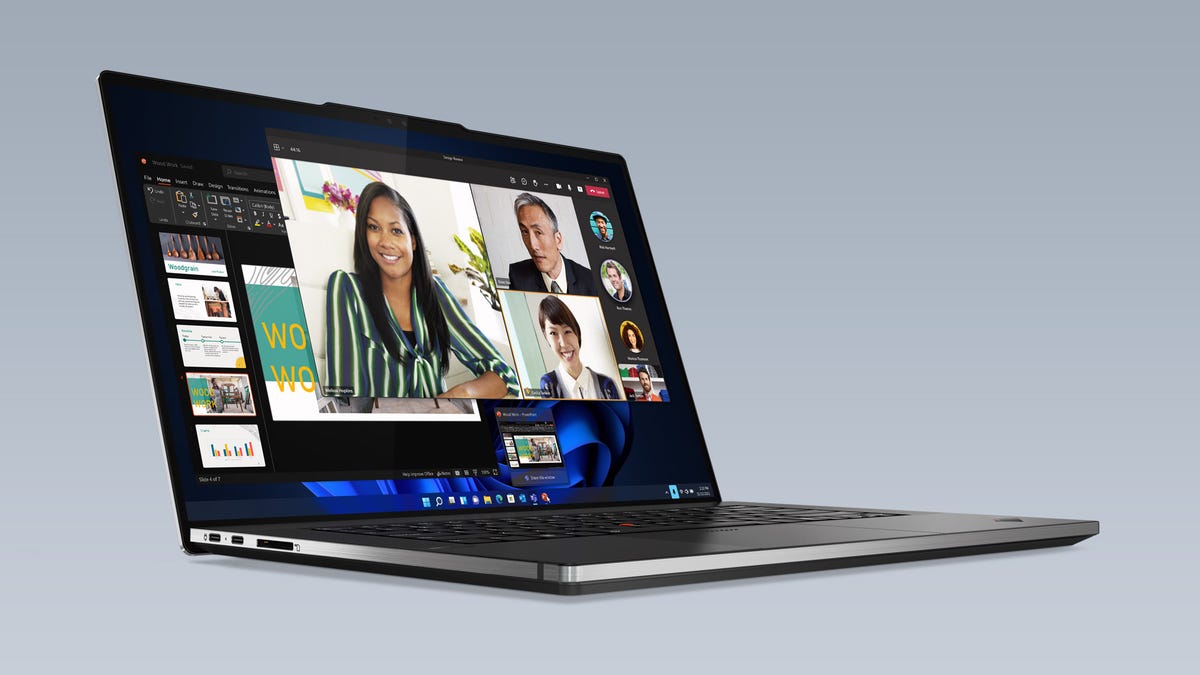
The ThinkPad Z line incorporates Ryzen Pro 6000 series processors, and is one of the first to take advantage of Microsoft's Pluton security architecture.
LenovoThe first AMD Advantage laptops, announced Tuesday, are the Alienware M17 Ryzen Edition R5 and Asus ROG Zephyrus G14. The Alienware will be available with up to the Ryzen 9 6980HX and RX 6850M XT, and it'll be the first system to ship with SmartAccess Graphics. The Zephyrus G14 will be a thin-and-light gaming laptop with up to the RX 6800S GPU. Other models will be available from custom PC builders, who buy their laptops from equipment manufacturers such as Origin PC.
As usual, there are also Pro variants of the various processors. This is the first generation of AMD's Ryzen Pro to incorporate Microsoft Pluton support into its own security stack. Pluton is an on-chip security technology with memory encryption that's supplied by Microsoft and which therefore gets the company's weekly patches and updates via the operating system. That could allow vulnerabilities to be patched more consistently and it could simplify the updates and fixes for manufacturers.
Lenovo's new line of ThinkPad Z laptops will be the first AMD models to add Pluton using a Ryzen 7 Pro CPU.
Source
Tags:
Blog Archive
-
▼
2022
(176)
-
▼
December
(57)
- Is Anxiety Ruining Your Sleep? 5 Tips To Relieve A...
- HBO Max's Raised By Wolves Combines Ridley Scott S...
- Microsoft Surface Laptop Go 2 Review: The Tricky M...
- WhatsApp Goes Down For Many Across Globe
- Apple MacBook Air (2018) Review: The New MacBook A...
- Anker Nebula Cosmos Laser 4K Projector Review: Get...
- Twitter Rolls Out A Way To Showcase Your NFTs
- At CES 2022, AMD Hit All The Gaming Targets
- You Can Finally Use Snapchat On Your Computer, But...
- Google Offering Pixel 4 XL Extended Repair Program
- Snapchat Warns Apple's Privacy Changes Could Hurt ...
- Google ChromeOS Flex Is Now Ready To Run Your Old ...
- How Much Cheaper Are Store-Brand Groceries Than Na...
- Save Big On Discounted Asus Desktop PCs, Laptops A...
- Apple's Rumored IPhone 14 Max Could Be The Giant I...
- Google: Bye-Bye, Bidets. Employees: Not So Fast.
- Google's Pixel 6 Phones Are Coming With A Chip Des...
- People Are Paying Millions For Land In The Metaver...
- Lil Nas X Headlines TikTok's New Collection Of NFTs
- TikTok May Have A Music App In The Works
- Tesla Now Has A Supercharger In Every US State Wit...
- The Bob's Burgers Movie Review: The Belchers Sizzl...
- Motorola's Back-to-School Sale Knocks Up To $600 O...
- Snapchat's Augmented Reality Lenses Can Span Whole...
- Black Adam Teaser Trailer Reveals The Rock In God ...
- Move Your Toddler Into A Big Kid Bed With These 5 ...
- Samsung To Overhaul Smartwatch With Galaxy Watch 4...
- All 8 Harry Potter Movies Are Coming Back To Peaco...
- Nvidia AI Tech Lets Computers Understand The 3D Wo...
- Disney Streams Fireworks To Celebrate Being Halfwa...
- Facebook-owned WhatsApp Launches New WhatsApp Busi...
- Best Places To Buy Specialty Foods Online
- Hit The Ground Running With 50% Off The Garmin Ven...
- Asus ZenBook 13 (2020) Review: This Small Laptop M...
- How To Win The New York Times Spelling Bee Every S...
- 'Oh No, Our Table, It's Broken' On TikTok: What It...
- The Best Ways To Make Awesome Coffee On The Cheap
- Mortgage Forbearance And Eviction Extensions Run T...
- Best Antivirus Software For 2022
- Living EV-Only With Our Long-Term Mini Cooper SE A...
- Doctors Call On Spotify To Stop COVID Misinformati...
- Samsung Galaxy Z Fold 3: Can The Upgrades Win Over...
- SolarWinds Hackers Accessed DHS Acting Secretary's...
- Honda And Sony Team Up To Build And Sell Electric ...
- Facebook Portal Plus Review: A Decent Video-chat D...
- Pokemon Go PokeStops Are Coming To Best Buy And Ga...
- Strengthen Your Heart Health With These Workouts
- Forest Bathing: The Free Cure For Stress And Anxiety?
- Earth Day 2022: 10 CNET Stories About The State Of...
- Computer Company Framework Wants You To Upgrade An...
- Pokemon Scarlet And Violet Teasing Another New Pok...
- Google Considered Using Drones For Firefighting
- Intel Warns That Price Hikes Are Coming This Year
- Apple Watch SE: If You've Been Holding Out On Buyi...
- Motorola's Edge Plus Puts A 60MP Selfie Camera Up ...
- The 563-HP M760e Is BMW M's First Plug-In Hybrid
- 'Stranger Things' Logo Lights Up As Halloween Costume
-
▼
December
(57)
